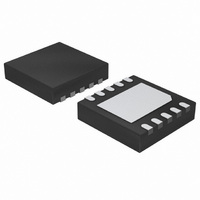NCP1835MN20R2G ON Semiconductor, NCP1835MN20R2G Datasheet - Page 7

NCP1835MN20R2G
Manufacturer Part Number
NCP1835MN20R2G
Description
IC BATT CHRGR LI-ION 4.2V 10-DFN
Manufacturer
ON Semiconductor
Type
Battery Chargerr
Datasheet
1.NCP1835MN20R2G.pdf
(16 pages)
Specifications of NCP1835MN20R2G
Function
Charge Management
Battery Type
Lithium-Ion (Li-Ion)
Voltage - Supply
2.8 V ~ 6.5 V
Operating Temperature
-20°C ~ 70°C
Mounting Type
Surface Mount
Package / Case
10-VFDFN Exposed Pad
Output Voltage
4.2 V
Output Current
1000 mA
Operating Supply Voltage
2.8 V to 6.5 V
Maximum Operating Temperature
+ 70 C
Minimum Operating Temperature
- 20 C
Mounting Style
SMD/SMT
Operating Supply Voltage (min)
2.8V
Operating Supply Voltage (max)
6.5V
Operating Temp Range
-20C to 70C
Package Type
DFN
Mounting
Surface Mount
Pin Count
10
Operating Temperature Classification
Commercial
Lead Free Status / RoHS Status
Lead free / RoHS Compliant
Other names
NCP1835MN20R2G
NCP1835MN20R2GOSTR
NCP1835MN20R2GOSTR
Available stocks
Company
Part Number
Manufacturer
Quantity
Price
Part Number:
NCP1835MN20R2G
Manufacturer:
ON/安森美
Quantity:
20 000
Overview
charged with a constant current (CC) until the terminal
voltage reaches a fixed voltage threshold, at which point a
constant voltage (CV) is applied and the current drawn by
the battery decays. The charging rate is determined by the
specific rating of the battery. For example, if the battery is
rated at 800 mA−hours, then the recommended maximum
charge rate is 800 mA. For a severely discharged cell, it
takes approximately 2.5−3.5 hours to recharge the battery
at the maximum rate. So, when one charges at less than the
maximum charge rate, the recharge time increases. Also,
the battery should not be continuously charged or the
battery could age faster than necessary. Because of this,
Li−Ion charging systems need to stop charging within a
prescribed time limit regardless of the charge rate.
Li−Ion charger which performs the primary battery
charging functions and includes a timer which will
terminate charging if the battery has not completed
charging within a prescribed time period. The charging rate
is user programmable up to 1.0 A and the end−of−charge
timer is also programmable. The NCP1835 has a thermal
foldback loop which reduces the charge rate if the junction
temperature is exceeded. The device also includes several
outputs which can be used to drive LED indicators or
interface to a microprocessor to provide status information.
The adapter providing power to the charger can be a
standard fixed output voltage such as a 5.0 V wall adapter
or it can be a simple current limited adapter.
regulation thresholds of 4.2 or 4.242 V depending on the
requirements of the specific battery pack being used. The
user determines the charge current by selecting the resistor
R
timeout timer by selecting the capacitor, C
Charging Operation
NCP1835 and Figure 14 graphically illustrates this. When
the charger is powered up and the input voltage rises above
the power−on, rising threshold (nominally 3.4 V), the
charger initiates the charging cycle.
less than the pre−charge threshold (2.8 V), the IC
ISEL
Rechargeable Li−Ion/Polymer batteries are normally
The NCP1835 is a fully integrated, stand−alone 1−cell
The NCP1835 comes in two versions with output voltage
Figure 13 outlines the charging algorithm of the
The NCP1835 first determines the cell voltage. If it is
and determines the length of the end−of−charge
DETAILED OPERATING DESCRIPTION
TIME
.
http://onsemi.com
7
recognizes the battery as severely discharged. In this state,
the NCP1835 pre−conditions (trickle charges) the battery
by charging it at 10% of the full charge rate (I
charge prevents the battery from being damaged from high
fast charge currents when it is in a deeply discharged state.
The battery voltage should be trickle charged up to 2.8 V
before 1/8 of the preset end−of−charge time is expired. If
it cannot reach this voltage, than the battery is possibly
shorted or damaged. Therefore, the NCP1835 stops
charging and the pre−charge timeout signal asserts the
FAULT flag.
the device will transition to normal (full−rate) charging at
100% of the programmed full rate charge current (I
As the NCP1835 charges the battery, the cell voltage rises
until it reaches the V
maximum charge rate, it normally takes about 1 hour to
reach this point from a fully discharged state, and the
battery will be approximately 70−80% recharged. At this
point, the charge transitions to constant voltage mode
where the IC forces the battery to remain at a constant
voltage, V
current required to maintain V
battery approaches full charge. Charge current eventually
falls to a very low value as the battery approaches a fully
charged condition.
it drops to 10% of the full charge rate. This is the
End−of−Charge (EOC) threshold. Normally it takes
1.5−2.5 hours to reach this point. Once the NCP1835
reaches end−of−charge it opens the CFLG pin and enters
the EOC state. The IC continues to charge the battery until
it reaches TIMEOUT. At that point, the NCP1835 stops
charging. If the system does not reach EOC during the
TIMEOUT period, the NCP1835 views this as a system
fault and asserts the FAULT flag. If the battery voltage
drops below the recharge threshold (which can occur if the
battery is loaded), the IC reinitializes the charging
sequence and begins a new charge cycle. The recharge
voltage threshold, V
the battery voltage, but does not charge the battery. Again,
if the battery voltage drops below the recharge threshold
the IC reinitializes the charging sequence and begins a new
charge cycle.
Once the cell voltage crosses the pre−charge threshold,
The NCP1835 monitors the current into the battery until
In the inhibit state, the NCP1835 continues to monitor
REG
. During this constant voltage state, the
REG
RECH
threshold, (4.2 or 4.242 V). At the
, is nominally 4.03 V.
REG
steadily decreases as the
PC
). This slow
FCHG
).











